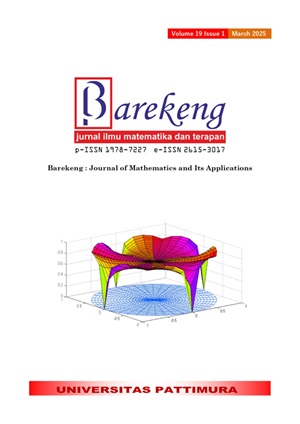APPLICATION OF CLASSIFICATION BASED ASSOCIATION (CBA) FOR MONKEYPOX DISEASE DETECTION
Abstract
Monkeypox is a zoonotic disease that can be transmitted from animals to humans. The monkeypox virus is the cause of monkeypox disease, which belongs to the orthopoxvirus family. Although the mortality rate from monkeypox is not as high as COVID-19, this virus can be the cause of the next global pandemic if the epidemic worsens. Therefore, it is very important to carry out proper surveillance and prevention to prevent the spread of this disease. In this study, researchers developed another method to detect monkeypox disease based on its symptoms using the classification by association (CBA) method. CBA integrates the advantages of classification and association analysis, allowing the classification process and a deeper understanding of the strength of the relationship between features in the dataset through the analysis of metrics such as support and confidence. Based on the results of the experiments in this study, an accuracy of 68.64%, a precision of 92.21%, and a sensitivity of 71.09% were obtained. In this case, the accuracy obtained is still low, but the results of other metrics show that the CBA model performs fairly well in predicting the positive class with high precision.
Downloads
References
WHO, “Mpox (monkeypox).” Accessed: Jan. 05, 2024. [Online]. Available: https://www.who.int/news-room/questions-and-answers/%0Aitem/monkeypox (
C. Sitaula and T. B. Shahi, “Monkeypox Virus Detection Using Pre-trained Deep Learning-based Approaches,” J. Med. Syst., vol. 46, no. 11, 2022, doi: 10.1007/s10916-022-01868-2.
D. Bala et al., “MonkeyNet: A robust deep convolutional neural network for monkeypox disease detection and classification,” Neural Networks, vol. 161, pp. 757–775, 2023, doi: 10.1016/j.neunet.2023.02.022.
K. P. Haripriya and H. Hannah Inbarani, “Performance Analysis of Machine Learning Classification Approaches for Monkey Pox Disease Prediction,” in 2022 6th International Conference on Electronics, Communication and Aerospace Technology, IEEE, Dec. 2022, pp. 1045–1050. doi: 10.1109/ICECA55336.2022.10009407.
A. Farzipour, R. Elmi, and H. Nasiri, “Detection of Monkeypox Cases Based on Symptoms Using XGBoost and Shapley Additive Explanations Methods,” Diagnostics, vol. 13, no. 14, 2023, doi: 10.3390/diagnostics13142391.
A. I. Saleh and A. H. Rabie, “Human monkeypox diagnose (HMD) strategy based on data mining and artificial intelligence techniques,” Comput. Biol. Med., vol. 152, no. November 2022, p. 106383, 2023, doi: 10.1016/j.compbiomed.2022.106383.
W. Anugrah, E. Haerani, Yusra, and L. Oktavia, “Klasifikasi Penyakit Cacar Monyet Menggunakan Metode Support Vector Machine,” Journal of Computer System and Informatics (JoSYC), 5(3), 558-566.
W. Wu, S. Wang, B. Liu, Y. Shao, and W. Xie, “A novel software defect prediction approach via weighted classification based on association rule mining,” Eng. Appl. Artif. Intell., vol. 129, p. 107622, Mar. 2024, doi: 10.1016/j.engappai.2023.107622.
J. Alwidian, B. H. Hammo, and N. Obeid, “WCBA: Weighted classification based on association rules algorithm for breast cancer disease,” Appl. Soft Comput. J., vol. 62, pp. 536–549, 2018, doi: 10.1016/j.asoc.2017.11.013.
J. Piri and P. Mohapatra, “Exploring Fetal Health Status Using an Association Based Classification Approach,” in 2019 International Conference on Information Technology (ICIT), IEEE, Dec. 2019, pp. 166–171. doi: 10.1109/ICIT48102.2019.00036.
F. H. YAĞIN, B. YAĞIN, A. K. ARSLAN, and C. ÇOLAK, “Comparison of Performances of Associative Classification Methods for Cervical Cancer Prediction: Observational Study,” Turkiye Klin. J. Biostat., vol. 13, no. 3, pp. 266–272, 2021, doi: 10.5336/biostatic.2021-84349.
K. Maharana, S. Mondal, and B. Nemade, “A review: Data pre-processing and data augmentation techniques,” Glob. Transitions Proc., vol. 3, no. 1, pp. 91–99, Jun. 2022, doi: 10.1016/j.gltp.2022.04.020.
S.-A. N. Alexandropoulos, S. B. Kotsiantis, and M. N. Vrahatis, “Data preprocessing in predictive data mining,” Knowl. Eng. Rev., vol. 34, p. e1, Jan. 2019, doi: 10.1017/S026988891800036X.
I. W. Saputro and B. W. Sari, “Uji Performa Algoritma Naïve Bayes untuk Prediksi Masa Studi Mahasiswa,” Creat. Inf. Technol. J., vol. 6, no. 1, p. 1, 2020, doi: 10.24076/citec.2019v6i1.178.
F. Liu, X. Zhou, Z. Wang, J. Cao, H. Wang, and Y. Zhang, “Unobtrusive Mattress-Based Identification of Hypertension by Integrating Classification and Association Rule Mining,” Sensors, vol. 19, no. 7, p. 1489, Mar. 2019, doi: 10.3390/s19071489.
D. Dietrich, B. Heller, and B. Yang, Data science and big data analytics: discovering, analyzing, visualizing and presenting data. Wiley, 2015.
K. G. Curran et al., “HIV and Sexually Transmitted Infections Among Persons with Monkeypox — Eight U.S. Jurisdictions, May 17–July 22, 2022,” MMWR. Morb. Mortal. Wkly. Rep., vol. 71, no. 36, pp. 1141–1147, Sep. 2022, doi: 10.15585/mmwr.mm7136a1.
Copyright (c) 2025 Qoria Yudi Pratama, Mohammad Isa Irawan

This work is licensed under a Creative Commons Attribution-ShareAlike 4.0 International License.
Authors who publish with this Journal agree to the following terms:
- Author retain copyright and grant the journal right of first publication with the work simultaneously licensed under a creative commons attribution license that allow others to share the work within an acknowledgement of the work’s authorship and initial publication of this journal.
- Authors are able to enter into separate, additional contractual arrangement for the non-exclusive distribution of the journal’s published version of the work (e.g. acknowledgement of its initial publication in this journal).
- Authors are permitted and encouraged to post their work online (e.g. in institutional repositories or on their websites) prior to and during the submission process, as it can lead to productive exchanges, as well as earlier and greater citation of published works.






1.gif)



